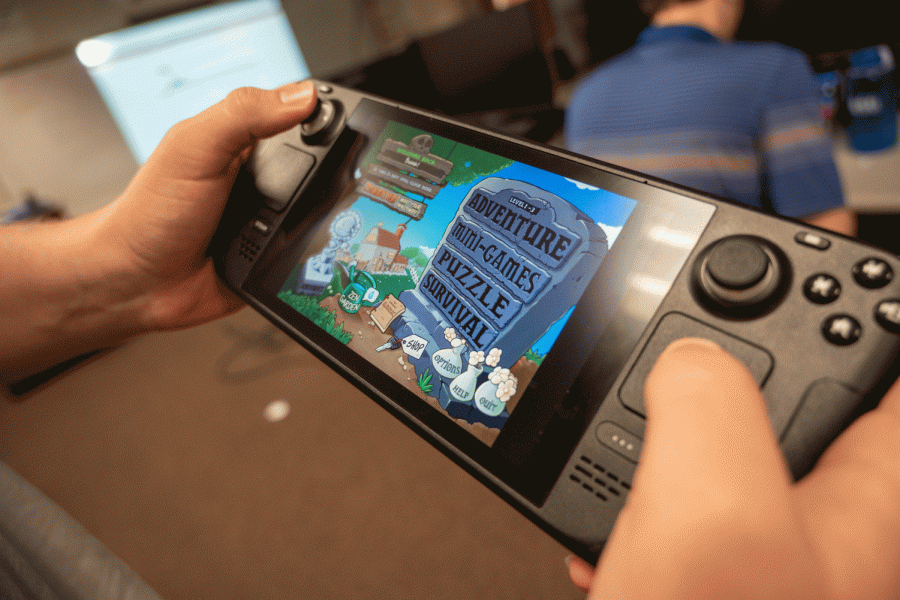The biggest thing to happen to computers in decades is in my hands.
Clark Chamberlin 24′ plays Plants vs. Zombies on the Steam Deck.
September 14, 2022
After a long 13-month wait, I finally received the greatest lump of plastics and silicon I’ve ever laid eyes on. In just one week, this 1.5 pound glorified iPad has become my favorite electronic device, and that’s saying a lot: I’ve derived more enjoyment from this little handheld than my giant 2-thousand-dollar desktop PC. The Steam Deck was everything I expected it to be and more.
A bit of a recap: July, 2021: Valve, the infrequently productive video game company that owns the premier PC game distribution program Steam, announces pre-orders for a new handheld computer, created out of collaboration between Valve and AMD. The device is small enough that it can fit in (dangle precariously out of) a pocket, yet can still play demanding AAA titles. When I preordered mine four days after they announced it, it wouldn’t be until months later in early March 2022 that the first Decks would be shipped.
Mine didn’t come until four months after that in mid-August. For the year-long wait, to say I was excited would be a greater understatement than the Black Knight’s “‘tis but a scratch.” I wrote a huge article about it in April 2022, and my expectations and hopes for this device would not stop growing. Somehow, against all odds, the Steam Deck was even better than I thought it was going to be. But what makes the device so amazing?
First, the ergonomics. This device is simply fun to hold. Valve obviously drew some inspiration from the switch, but they improved on it by making it possible to use without feeling like I received a very aggressive handshake from Mike Tyson. The front of the device is contoured to slope downward at the bottom corners to more comfortably fit one’s hands, and on the left and right flank you’ll find grips that are designed to perfectly accommodate the natural shape of a hand. The controls look like they’d be very awkward, but using them feels anything but. I’ve never had a hand cramp up on me using this device, meanwhile in my limited experience using modern Nintendo handhelds my palms need rehab after 10 minutes. In addition, despite it weighing significantly more than the Switch, its weight never distracts from the game you’re playing. The only reason why you’ll be distracted by the device itself would be amazement at how comfortable it is.
Second, the controls themselves. Nothing really stands out for the sticks, D-Pad, triggers, or face buttons, but the trackpads and grip buttons are immensely useful. A trackpad is a far better way to simulate a mouse than an analog stick, especially when using the gyro for more precise aim. Trackpads can also be used for radial menus, scroll wheels, button inputs, and more. Arguably more important are the buttons on the back of the device. These four buttons can emulate the face buttons, you’ll never have to take your thumb off the trackpad or right stick. I’ve found this especially useful in any game that has camera control, like 3D platformers, twin stick shooters, and first/third games. In games like Super Mario Odyssey, one must control the camera while controlling a character. Controlling Mario requires the use of the ABXY buttons, and the camera requires the use of the right analog stick. One thumb can only do one or the other. By using the grip buttons as ABXY, which can easily be configured on the fly for any game via Steam Input, one doesn’t need to switch between moving the camera and being able to jump, both options are always available. This is even more important in games designed for a keyboard and mouse. For example, in Team Fortress Two, being able to jump is important. When fingers are on the analog stick or a trackpad, they can’t press the A button to jump. With the grip buttons, finally this basic mechanic of jumping while aiming can be performed on a controller.
Third, the computational power of the device. The processor was created out of a collaboration with AMD and is a 4 core 2.4-3.5GHz APU with 8 RDNA2 1.0-1.6GHz CUs. It has 16GB of LPDDR5 Ram, and a 1280×800 screen. The device is more than capable of extremely heavy and complicated workloads, including even emulation of the Nintendo Switch, allowing one to enjoy games even as visually impressive as Mario Kart 8 at full speed for 90% of the time. Even games that typically require beefier computers work well on the Steam Deck when run at a lower resolution. The story doesn’t end there for those games, though. The Deck can take the low-resolution image from the game and apply FSR, a sharpening technology, to make the image look as if it was rendered in HD. Every single Steam game I have thrown at the device so far has run beautifully, and the same can be said for many Switch games.
One can easily install Yuzu, a Nintendo Switch emulator, to play many games once exclusive to Nintendo’s hardware. This is how I’ve experienced Mario Kart 8, and frankly, I can’t think of a single better way. Yuzu will do nothing but improve, and though the Switch is still a relatively new console for emulation at merely five years old, the quality and capabilities of Yuzu is steadily rising. Perhaps in another five years, 90% of Switch games will be easily run on the Steam Deck. At that point, almost all games ever published on any Nintendo console would be within the Deck’s grasp.
Third, the software library. The Steam Deck is capable of playing over 75% of all the games on Steam. Valve has set out to test every single game on their platform, and so far, over 5000 titles have been marked as playable out of over 7000 titles reviewed. The launch library of the Steam Deck is bigger than the libraries many consoles get by the end of their life cycle. Even the Wii, which sold over 100 million units, only had about 1600 games licensed by Nintendo, including the mountains of shovelware (garbage video games) for the system. In addition to that, it’s an emulation dream, capable of playing nearly every game ever published on older consoles.
Finally, and most importantly, the freedom of the device is instrumental in its success. It’s literally just a PC. There is no difference between a Steam Deck and a standard laptop, except its size and controllers. You can even (if you REALLY want to) install other operating systems on the device, including standard Windows. The OS it comes with might pose a bit of a learning curve for some users, though, as the device ships running a Linux-based operating system. For a 4-year Linux user like me, everything is second nature, but for someone who’s never used Linux before, this might sound intimidating. Fret not, for not only is Linux far easier than its reputation leads people to believe, but also Valve has idiot-proofed the device extensively. Online, there’s lots of documentation for all of the software used on the device, and there’s plenty of forums for users to get help with problems one might encounter, such as making a particular game run that doesn’t work on Linux by default. One of my major hopes for the Steam Deck in the long term is spreading Linux adoption, as while Linux is (in my opinion) vastly superior to Windows and Mac, only 2% of computer users run it.
Being a Linux PC, you may have concerns about compatibility. Will your games run? Well, Valve has spent years working on a tool called Proton that translates Windows to Linux and back. This “compatibility layer” allows someone to play a game never designed for anything but Windows on a Linux computer flawlessly. Almost 80% of the top 100 Steam games work flawlessly or nearly flawlessly on Linux with the help of Proton. You can see what games work on protondb, a community run site where people can submit reports on their successes and failures in getting games to run, as well as clear and easy instructions on how to make problematic games playable.
You never have to deal with the Linux aspect if you don’t want to. Most users, myself included, only access the Linux desktop once or twice to add non-Steam programs and games. By default, the Deck starts up in Gaming Mode, in which everything from purchasing to playing games is easily managed using the controllers. If you only play Steam games on the device, you’d never know that the device was running on Linux. However, if you are willing to use Desktop Mode, you can access all your game libraries from other places, like emulators, Epic Games, or GoG. This is not just some “Steam console”, this is a normal computer that just so happens to look like a console.
In April I had talked about how there’s a long wait for getting a Steam Deck. At the time, one who wanted to place a reservation would likely have to wait even after 2023 started. Now, with a far greater production line, one who reserves today can expect theirs to ship before the year is out. The only thing you need to place an order is a Steam account, which is free, and five bucks to place a reservation. Those five dollars count towards the final purchasing cost. Once you reach the Steam Deck page to reserve one, you have a very important choice to make: which Deck is best for you?
There are three tiers of Steam Deck you can buy. To start, you have a very competitively priced $400 dollar model that comes with 64gb of eMMC flash storage. This storage isn’t the fastest and will only hold a few games, but if you’ve got a large micro SD card or you don’t plan on loading the device up with a lot of files or games, money spent on higher tiers might be wasted. Coming up next, the $530 model comes with a 256gb SSD. This is more than enough to hold many games, and for those who aren’t going to be filling the storage up that much is likely the best option. For reference, of all the files on my Deck, Steam games only make up about 100gb, with about 290gb taken up by other files like my ROM library. The final tier is the $650 model with a 512gb SSD, more than enough for most people. It also comes with a carrying case, saving you a 20-50 dollar amazon purchase.
I believe the Steam Deck is the best computer produced since the days of 3dfx. Buy it.








